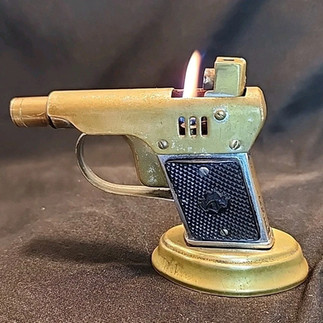Collecting Vintage Lighters: The Underrated Japanese Table Lighter
- Vintage Flame Revival

- Oct 3
- 2 min read
I’ve been observing seasoned vintage lighter collectors for a while now. There are certain brands and makes that always seem to make collectors swoon—while Japanese lighters are often overlooked. Personally, I believe vintage Japanese lighters are underrated and make a fantastic entry point for new collectors, especially when it comes to table lighters.
A Brief History
After WWII, from 1945 to 1952, Japan was under Allied occupation and required to demilitarize its industries. This meant factories that once produced military equipment had to shift toward everyday household items. Among these items were lighters. Manufacturing and exporting goods like lighters played a significant role in rebuilding Japan’s economy.
It’s worth noting that not all Japanese lighters were born out of this postwar shift. For example, IM Corona, a well-known maker of high-quality lighters, was established in 1933—well before the war. They remain one of the most respected names in the industry today. But here, I’m focusing on the post-war lighters that emerged from demilitarization.
Dating Japanese Table Lighters
One of the benefits of collecting Japanese lighters is how easy they are to roughly date. Lighters produced between 1945 and 1952 are marked “Made in Occupied Japan.” These hold a special place in history, as they were part of Japan’s transition away from wartime production. Because of that, they are often considered a bit more valuable than post-1952 lighters, which are simply marked “Made in Japan.”
Basic Inserts, Endless Possibilities
During this time, Japan mass-produced a standard style of lighter insert that could be fitted into countless bases. These inserts were inexpensive to manufacture, but surprisingly well made. Japan even exported them to other countries for use in locally designed bases.
There were two main shapes: round and oblong. While these inserts aren’t considered “high-end,” they’re terrific for collectors—especially beginners—because they’re easy to repair or replace. This makes them an accessible, affordable, and fun way to start a collection.
Pictured are nine examples of mid-century table lighter with Japanese made lighter inserts. No. 8 was glass made in France. No 9 was glass made in Murano, Italy, both used Japanese inserts.
Other Types Worth Exploring
Not all Japanese table lighters relied on removable inserts. Some had built-in mechanisms, which can be trickier to restore but are equally fascinating. Among the most collectible are the pistol lighters, which were produced in all kinds of shapes and sizes. Many of these designs blurred the line between pocket and table lighters, with some models featuring removable bases so they could function as both.
Final Thoughts
Japanese table lighters may not carry the prestige of some European or American brands, but they’re rich in history, affordable, and endlessly interesting to collect. Whether you’re a beginner or a seasoned enthusiast, these pieces offer both variety and charm—and in many cases, a unique window into Japan’s postwar resilience and creativity.
What’s your favorite lighter?



























Comments